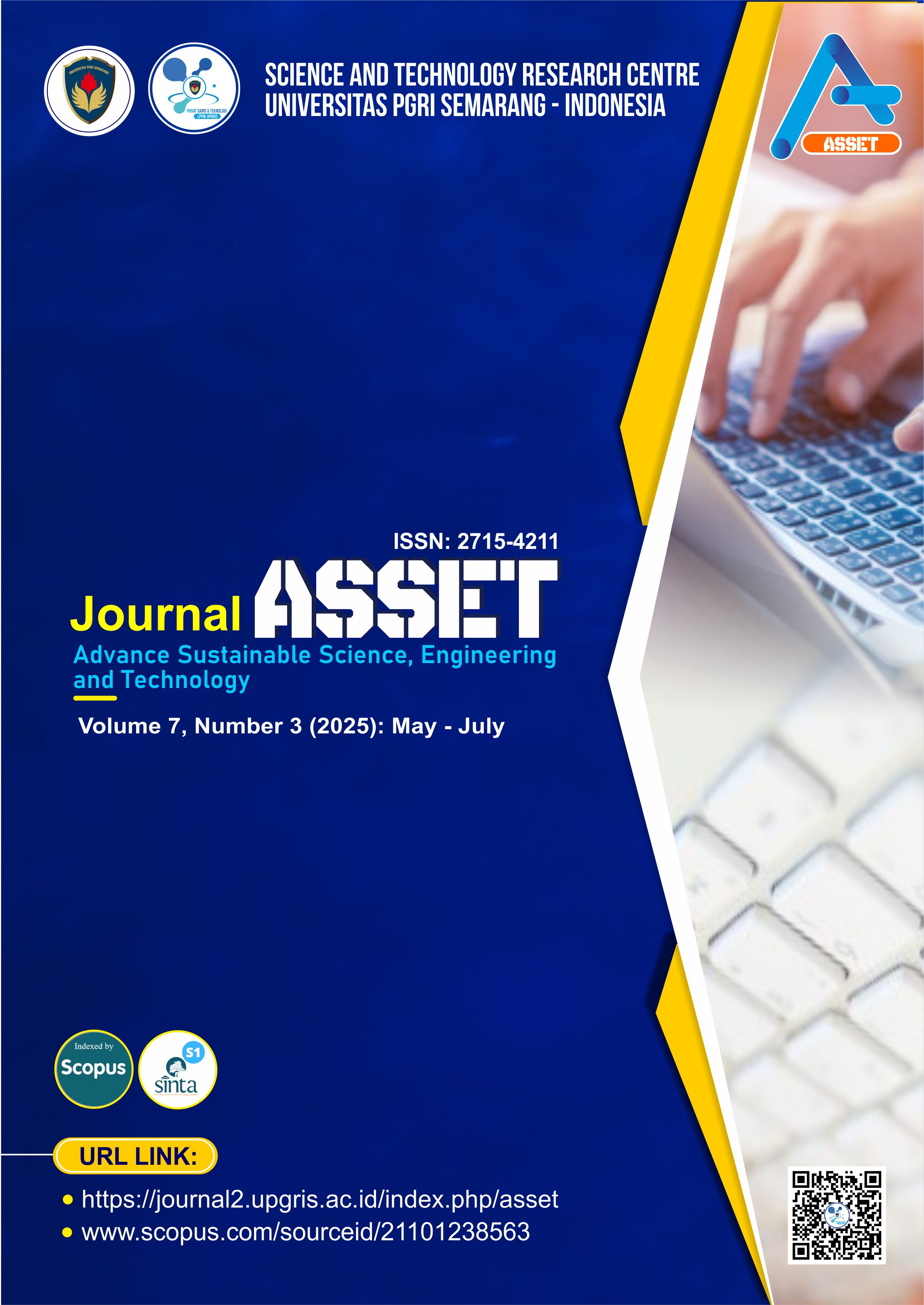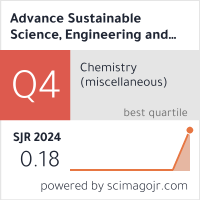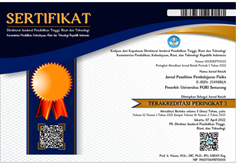Numerical Investigation of Consolidation Settlement for Runway Construction on Soft Soil: A Case Study in Sumbawa, Indonesia
DOI:
https://doi.org/10.26877/asset.v7i3.1805Keywords:
Finite Element Method (FEM), Numerical Modeling, Runway, Soft Soil, TransportationAbstract
Runway construction on soft soil presents significant engineering challenges due to excessive settlement, which can affect structural stability and long-term performance of transportation infrastructure. This study investigates the settlement of a runway in Sumbawa, Indonesia using the Finite Element Method (FEM) in Plaxis 2D. The Hardening Soil Model was applied to realistically capture nonlinear soil behavior. Input parameters were derived from a series of N-SPT data and laboratory test results. The findings indicate that during the operational phase, the maximum and minimum settlement were 307.1 mm and 2.491x10-3 mm, respectively. Meanwhile, consolidation-induced settlement reached a maximum of 357.97 mm and a minimum of 10.6 mm. The distribution of total settlement along the runway varied depending on soil characteristics. Sections with predominantly clayey soil exhibited greater settlement, whereas areas with sandy soil experienced significantly lower settlement.
References
[1] Y. Zaika, A. Rachmansyah, and Harimurti, “Geotechnical behaviour of soft soil in East Java, Indonesia,” IOP Conf. Ser. Mater. Sci. Eng., vol. 615, no. 1, 2019, doi: 10.1088/1757-899X/615/1/012043.
[2] N. Juliana and N. F. B. Bawadi, “Effects of Physical and Mechanical Properties of Soft Soil on Subgrades Performances in Lubuk Bayas Village, Serdang Bedagai Regency,” IOP Conf. Ser. Earth Environ. Sci., vol. 1216, no. 1, 2023, doi: 10.1088/1755-1315/1216/1/012017.
[3] Badan geologi, Atlas Sebaran Tanah Lunak Indonesia. 2019.
[4] A. M. Permana and P. P. Rahardjo, “The site characterization of central jakarta soft soil using CPTu and laboratory test,” Indones. Geotech. J., vol. 1, no. 1, pp. 25–40, 2022, doi: 10.56144/igj.v1i1.6.
[5] I. Prasetia, H. Hutagamissufardal, A. Jimmy, and M. D. K. Ananda, “Experimental investigation on the properties of Borneo soft soil stabilized with industrial waste,” Int. J. Eng. Manag. Sci., vol. 9, no. 1, pp. 25–37, 2023, doi: 10.21791/ijems.2023.040.
[6] A. S. Balasubramaniam and R. P. Brenner, “Consolidation and settlement of soft clay,” Dev. Geotech. Eng., vol. 20, no. C, pp. 479–566, 1981, doi: 10.1016/B978-0-444-41784-8.50010-1.
[7] B. M. Das, “Consolidation settlement of shallow foundations,” Adv. Soil Mech., pp. 561–594, 2020, doi: 10.1201/b15955-12.
[8] Q. Zhou, X. Chen, Z. Liu, G. Liu, and L. Ma, “Test study on secondary consolidation behavior of soft soil under different loading paths,” IOP Conf. Ser. Earth Environ. Sci., vol. 510, no. 5, 2020, doi: 10.1088/1755-1315/510/5/052050.
[9] A. Verruijt, “Theory of Consolidation BT - Computational Geomechanics,” A. Verruijt, Ed. Dordrecht: Springer Netherlands, 1995, pp. 8–34.
[10] A. Verruijt, “An Introduction to Soil Dynamics,” An Introd. to Soil Dyn., no. December 2009, 2010, doi: 10.1007/978-90-481-3441-0.
[11] S. N. Amiri, A. Esmaeily, and A. Mahouti, “A Realistic Theory of Soils Consolidation,” no. Lekha 2003, pp. 3828–3837, 2011, doi: 10.1061/41165(397)391.
[12] B. P. Radhika, A. Krishnamoorthy, and A. U. Rao, “A review on consolidation theories and its application,” Int. J. Geotech. Eng., vol. 14, no. 1, pp. 9–15, 2020, doi: 10.1080/19386362.2017.1390899.
[13] Y. Li, J. Qian, Z. Shi, and H. Zhang, “Prediction of Airport Taxiway Settlement based on CNNBiLSTM-Attention,” IOP Conf. Ser. Earth Environ. Sci., vol. 1337, no. 1, 2024, doi: 10.1088/1755-1315/1337/1/012028.
[14] D. Zheng, J. Huang, D. Q. Li, R. Kelly, and S. W. Sloan, “Embankment prediction using testing data and monitored behaviour: A Bayesian updating approach,” Comput. Geotech., vol. 93, pp. 150–162, 2018, doi: 10.1016/j.compgeo.2017.05.003.
[15] K. Terzaghi, R. B. Peck, and G. Mesri, Soil mechanics in engineering practice. John wiley & sons, 1996.
[16] J. E. Bowles, Foundation Analysis and Design International Fifth Edition. 1997.
[17] Ö. Bilgin and E. Mansour, “Variability of Soil Properties and Reliability of Empirical Equations on Soil Settlement Predictions,” pp. 298–307, 2013, doi: 10.1061/9780784412763.024.
[18] R. Kelly and J. Huang, “Bayesian updating for one-dimensional consolidation measurements,” Can. Geotech. J., vol. 52, no. 9, pp. 1318–1330, 2015, doi: 10.1139/cgj-2014-0338.
[19] A. Baghbani, T. Choudhury, S. Costa, and J. Reiner, “Application of artificial intelligence in geotechnical engineering: A state-of-the-art review,” Earth-Science Rev., vol. 228, p. 103991, 2022, doi: https://doi.org/10.1016/j.earscirev.2022.103991.
[20] A. Elgamal, “Guidelines for Geotechnical Finite-Element Modeling,” Open Civ. Eng. J., vol. 15, no. 1, pp. 424–440, 2022, doi: 10.2174/1874149502115010424.
[21] Roesyanto, R. Iskandar, S. A. Silalahi, and Fadliansyah, “Soil settlement analysis in soft soil by using preloading system and prefabricated vertical draining runway of Kualanamu Airport,” IOP Conf. Ser. Mater. Sci. Eng., vol. 309, no. 1, 2018, doi: 10.1088/1757-899X/309/1/012024.
[22] Moamen E. Abd El Raouf, “FINITE ELEMENT ANALYSIS OF EMBANKMENTS ON SOFT CLAY,” J. Al-Azhar Univ. Eng. Sect., vol. 15, no. 57, pp. 963–970, 2020.
[23] A. Meilani, R. Ahmad, and F. Fikri, “Analysis of settlement prediction due to preloading and vertical drain applications on runway construction,” E3S Web Conf., vol. 156, pp. 2–6, 2020, doi: 10.1051/e3sconf/202015602002.
[24] H. Farichah, D. A. Hutama, and D. P. Solin, “Numerical Analysis of Soft Soil Improvement using Pile at Airport Construction Project,” J. Adv. Civ. Environ. Eng., vol. 6, no. 2, p. 107, 2023, doi: 10.30659/jacee.6.2.107-117.
[25] P. YANG, J. Yang, D. Xu, and Y. Xiao, “FINITE ELEMENT ANALYSIS OF SETTLEMENT OF SOFT SOIL FOUNDATION UNDER RESERVOIR DAM,” J. Eng. Geol., vol. 16, no. 4, pp. 533–538, 2008, [Online]. Available: http://www.gcdz.org/en/article/id/8665.
[26] S. A. Saputro, A. Setyo Muntohar, and H. Jiun Liao, “Ground settlement prediction of embankment treated with prefabricated vertical drains in soft soil,” MATEC Web Conf., vol. 195, 2018, doi: 10.1051/matecconf/201819503014.
[27] Z. Razak, M. Mukri, and N. A. Kasim, “Prediction of settlement by using finite element simulation 2D program at Seksyen 7, Shah Alam,” AIP Conf. Proc., vol. 1875, no. April, 2017, doi: 10.1063/1.4998375.
[28] B. Al Hanif and A. N. Al Islami, “CASE STUDY OF REPLACEMENT METHOD ON ROAD EMBANKMENT OVER A DEEP SOFT SOIL,” Int. J. Civ. Eng. Infrastruct., vol. 4, no. 1, 2024.
[29] S. Rokhim, A. Purnama, P. Astuti, and D. Latif, Finite-Element Analysis of the Settlement Behavior Under the Staged Construction of Road Embankment Project. 2024.
[30] N. Müthing, C. Zhao, R. Hölter, and T. Schanz, “Settlement prediction for an embankment on soft clay,” Comput. Geotech., vol. 93, pp. 87–103, 2018, doi: 10.1016/j.compgeo.2017.06.002.
[31] J. Chai, Y. Igaya, T. Hino, and J. Carter, “Finite element simulation of an embankment on soft clay - Case study,” Comput. Geotech., vol. 48, pp. 117–126, 2013, doi: 10.1016/j.compgeo.2012.10.006.
[32] J. J. Muhammed, P. W. Jayawickrama, and S. Ekwaro-Osire, “Uncertainty analysis in prediction of settlements for spatial prefabricated vertical drains improved soft soil sites,” Geosci., vol. 10, no. 2, pp. 1–24, 2020, doi: 10.3390/geosciences10020042.
[33] A. J. Klettke and L. Edgers, “A comparison of 1D, 2D, and 3D settlement analyses of the Tower of Pisa,” Numer. Methods Geotech. Eng. - Proc. 7th Eur. Conf. Numer. Methods Geotech. Eng., vol. 41165, no. November, pp. 535–540, 2010, doi: 10.1201/b10551-98.
[34] M. Carter and S. Bentley, Soil Properties and their Correlations: Second Edition. 2016.
[35] J. Ameratunga, N. Sivakugan, and B. M. Das, Correlations of Soil and Rock Properties in Geotechnical Engineering. 2016.
[36] S.-C. Lo, J. Mak, C. Gnanendran, R. Zhang, and G. Manivannan, “Long-term performance of a wide embankment on soft clay improved with prefabricated vertical drains,” Can. Geotech. J., vol. 45, pp. 1073–1091, Jul. 2008, doi: 10.1139/T08-037.
[37] X. T. Wu, J. N. Liu, A. Alowaisy, N. Yasufuku, R. Ishikura, and M. Adriyati, “Settlement Forecast of Marine Soft Soil Ground Improved with Prefabricated Vertical Drain-Assisted Staged Riprap Filling,” Buildings, vol. 14, no. 5, pp. 1–23, 2024, doi: 10.3390/buildings14051316.
[38] M. Ayeldeen and R. Thurner, “Studying the behavior of soft soil improved with prefabricated vertical drains. Case study,” 11th Int. Conf. Geosynth. 2018, ICG 2018, vol. 2, no. September, pp. 1525–1532, 2018.











